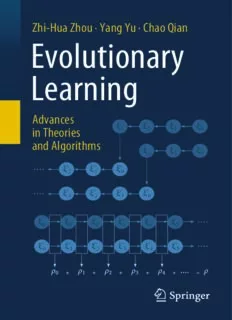Table Of ContentZhi-Hua Zhou · Yang Yu · Chao Qian
Evolutionary
Learning
Advances
in Theories
and Algorithms
Evolutionary Learning: Advances in Theories
and Algorithms
Zhi-Hua Zhou Yang Yu
(cid:129) (cid:129)
Chao Qian
Evolutionary Learning:
Advances in Theories
and Algorithms
123
Zhi-Hua Zhou Yang Yu
NanjingUniversity NanjingUniversity
Nanjing, Jiangsu,China Nanjing, Jiangsu,China
ChaoQian
NanjingUniversity
Nanjing, Jiangsu,China
ISBN978-981-13-5955-2 ISBN978-981-13-5956-9 (eBook)
https://doi.org/10.1007/978-981-13-5956-9
©SpringerNatureSingaporePteLtd.2019
Thisworkissubjecttocopyright.AllrightsarereservedbythePublisher,whetherthewholeorpart
of the material is concerned, specifically the rights of translation, reprinting, reuse of illustrations,
recitation, broadcasting, reproduction on microfilms or in any other physical way, and transmission
orinformationstorageandretrieval,electronicadaptation,computersoftware,orbysimilarordissimilar
methodologynowknownorhereafterdeveloped.
The use of general descriptive names, registered names, trademarks, service marks, etc. in this
publicationdoesnotimply,evenintheabsenceofaspecificstatement,thatsuchnamesareexemptfrom
therelevantprotectivelawsandregulationsandthereforefreeforgeneraluse.
The publisher, the authors and the editors are safe to assume that the advice and information in this
book are believed to be true and accurate at the date of publication. Neither the publisher nor the
authors or the editors give a warranty, expressed or implied, with respect to the material contained
hereinorforanyerrorsoromissionsthatmayhavebeenmade.Thepublisherremainsneutralwithregard
tojurisdictionalclaimsinpublishedmapsandinstitutionalaffiliations.
ThisSpringerimprintispublishedbytheregisteredcompanySpringerNatureSingaporePteLtd.
The registered company address is: 152 Beach Road, #21-01/04 Gateway East, Singapore 189721,
Singapore
Preface
Aroundtheyearof2001,thefirstauthorofthismonograph,Zhou,devel-
opedwithhiscollaboratorsapowerfulselectiveensembleapproach.This
approachisabletoproducesmall-sizedensembleswithgeneralizationper-
formanceevenstrongerthanthatoffull-sizedonesbyexploitinggenetical-
gorithm,apopularlyusedevolutionaryalgorithm(EA).Zhourealizedthat
EAs are powerful optimization techniques that can be well useful in vari-
ousmachinelearningtasks.Atthattime,however,EAswerealmostpurely
heuristic,notfavoredbythemachinelearningcommunitywithstrongthe-
oreticalflavor.ImpressedbythesuccessesofEAsinapplications,Zhoube-
lievedtheremustbesometheoreticalexplanationsbehindtheirmysteries
and decided to start this track of research. In 2004, the second author of
thismonograph,Yu,finishedhisbachelorthesisonselectiveensembleun-
derthesupervisionofZhou.YuthenjoinedZhouasaPhDstudenttaking
theoreticalaspectsofEAsashisthesistopic,andobtainedPhDdegreein
2011.In2009,Zhouacceptedthethirdauthorofthismonograph,Qian,as
hisPhDstudentwiththeoriesandalgorithmsofevolutionarylearningfor
histhesistopic,andQianobtainedhisPhDdegreein2015.Overall,thema-
jority of contents in this monograph are research results achieved by the
authors during the past two decades.
Thismonographiscomposedoffourparts.PartIbrieflyintroducesevo-
lutionarylearningandsomepreliminaries.Aimingatanalyzingtherunning
timecomplexityandtheapproximationability,thetwoessentialtheoretical
aspectsofEAs,PartIIpresentstwogeneralapproachesforderivingrunning
timeboundsandageneralframeworkforcharacterizingtheapproximation
performance.Theseresultsserveasgeneraltoolsforattainingmanytheo-
reticalresultsreportedintheremainderofthemonograph.PartIIIpresents
aseriesoftheoreticalstudies,mainlyabouttheinfluenceofmajorfactors,
such as recombination, solution representation, inaccurate fitness evalu-
ation,population,etc.,ontheperformanceofEAs.InPartIV,theauthors
comebacktoselectiveensemble,theiroriginalmotivatingtaskforstudy-
ingEAs,andpresentalgorithmsbehavingatleastaswellasstate-of-the-art
VI Preface
selectiveensemblealgorithms.Theauthorsthenstudysubsetselection,a
moregeneralproblemwidelyoccurringinvariousmachinelearningtasks,
andpresentaseriesofevolutionarylearningalgorithmswithboundedap-
proximationguarantees.
TheauthorshopethatthegeneraltheoreticaltoolspresentedinPartII
can be found useful for interested readers to explore theoretical founda-
tions of evolutionary learning, the theoretical results presented in Part III
canhelpreaderstogetmoreunderstandingaboutbehaviorsofevolution-
arylearningprocessesandoffersomeinsightforalgorithmdesign,andthe
algorithmspresentedinPartIVcanbefoundusefulinreal-worldapplica-
tionsofmachinelearning.
The authors want to thank their families, friends and collaborators.
GratitudegoestoCelineChangandAlfredHofmannwhoencouragedauthors
topublishthismonographwithSpringer.
Theauthors
February2019
Notations
R realnumber
N integer
(·)+ positive,(·)canbeRorN
(·)0+ non-negative,(·)canbeRorN
x variable
x vector
(·,·,...,·) rowvector
0,1 all-0sandall-1svectors
|·| ,|·| numberof0sand1sofavector
0 1
{0,1}n Booleanvectorspace
X matrix
(·)T transposeofavector/matrix
X set
{·,·,··· ,·}setbyenumeration
[n] set{1,2,...,n}
|·| cardinalityofaset
2X powersetofX,whichconsistsofallsubsetsofX
X\Y complementofY inX,whichconsistsofelements
inX butnotinY
VIII Notations
x stateofaMarkovchain
X statespaceofaMarkovchain
P(·),P(·|·) probabilityandconditionalprobability
π probabilitydistribution
f function
E·∼π[f(·)],E·∼π[f(·)|·]expectation and conditional expectation of f(·)
underdistributionπ,simplifiedasE[f(·)],E[f(·)|·]
whenthemeaningisclear
I(·) indicator function which takes 1 if · is true, and 0
otherwise
(cid:2)·(cid:3),(cid:4)·(cid:5) floor and ceiling functions which take the great-
est/leastintegerless/greaterthanorequaltoareal
number
OPT optimalfunctionvalue
(cid:2)
H n-thharmonicnumber,i.e., n (1/i)
n i=1
∀ forall
∃,(cid:2) thereexists,doesnotexist
Contents
PartI INTRODUCTION
1 Introduction ............................................... 3
1.1 MachineLearning....................................... 3
1.2 EvolutionaryLearning ................................... 4
1.3 Multi-objectiveOptimization............................. 6
1.4 OrganizationoftheBook................................. 9
2 Preliminaries............................................... 11
2.1 EvolutionaryAlgorithms ................................. 11
2.2 Pseudo-BooleanFunctions............................... 15
2.3 RunningTimeComplexity ............................... 17
2.4 MarkovChainModeling ................................. 19
2.5 AnalysisTools........................................... 21
PartII ANALYSISMETHODOLOGY
3 RunningTimeAnalysis:Convergence-basedAnalysis........... 29
3.1 Convergence-basedAnalysis:Framework.................. 30
3.2 Convergence-basedAnalysis:ApplicationIllustration....... 34
3.3 Summary............................................... 39
4 RunningTimeAnalysis:SwitchAnalysis....................... 41
4.1 SwitchAnalysis:Framework .............................. 41
4.2 SwitchAnalysis:ApplicationIllustration ................... 46
4.3 Summary............................................... 50
5 RunningTimeAnalysis:ComparisonandUnification .......... 51
5.1 AnalysisApproaches:Formalization....................... 51
5.2 SwitchAnalysisvs.FitnessLevel .......................... 53
X Contents
5.3 SwitchAnalysisvs.DriftAnalysis.......................... 57
5.4 SwitchAnalysisvs.Convergence-basedAnalysis............ 61
5.5 AnalysisApproaches:Unification ......................... 65
5.6 Summary............................................... 67
6 ApproximationAnalysis:SEIP................................ 69
6.1 SEIP:Framework ........................................ 70
6.2 SEIP:ApplicationIllustration ............................. 77
6.3 Summary............................................... 80
PartIII THEORETICALPERSPECTIVES
7 BoundaryProblemsofEAs................................... 83
7.1 BoundaryProblemIdentification ......................... 84
7.2 CaseStudy.............................................. 87
7.3 Summary............................................... 92
8 Recombination ............................................. 93
8.1 RecombinationandMutation ............................ 95
8.2 RecombinationEnabledMOEAs.......................... 97
8.3 CaseStudy.............................................. 100
8.4 EmpiricalVerification.................................... 106
8.5 Summary............................................... 108
9 Representation .............................................109
9.1 GeneticProgrammingRepresentation..................... 111
9.2 CaseStudy:MaximumMatchings......................... 113
9.3 CaseStudy:MinimumSpanningTrees..................... 119
9.4 EmpiricalVerification.................................... 125
9.5 Summary............................................... 128
10 InaccurateFitnessEvaluation ................................129
10.1 NoisyOptimization...................................... 130
10.2 InfluenceofNoisyFitness................................ 132
10.3 DenoisebyThresholdSelection........................... 136
10.4 DenoisebySampling .................................... 141
10.5 EmpiricalVerification.................................... 148
10.6 Summary............................................... 152
11 Population .................................................155
11.1 InfluenceofPopulation .................................. 156
11.2 RobustnessofPopulationagainstNoise ................... 160
11.3 Summary............................................... 172

